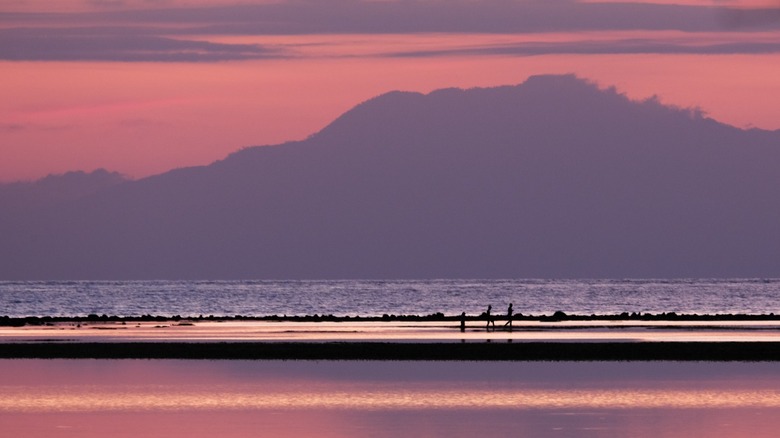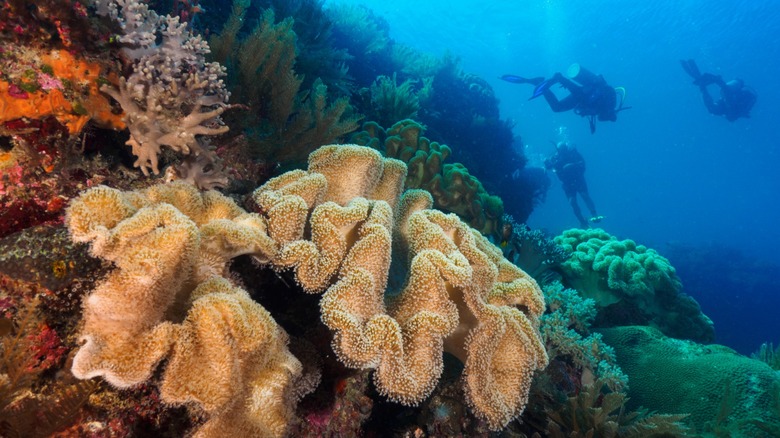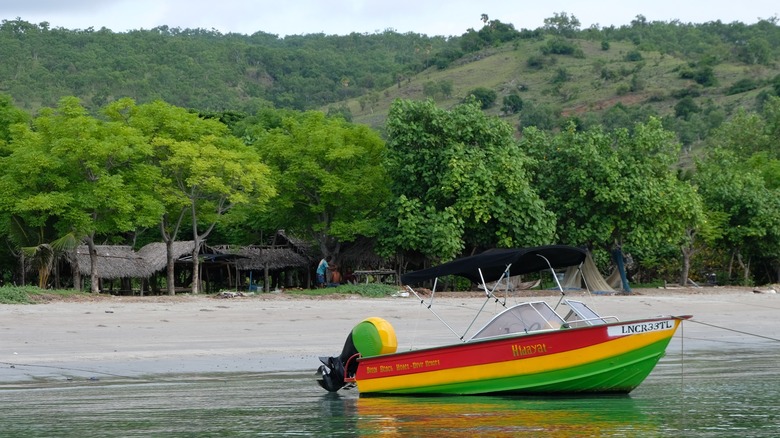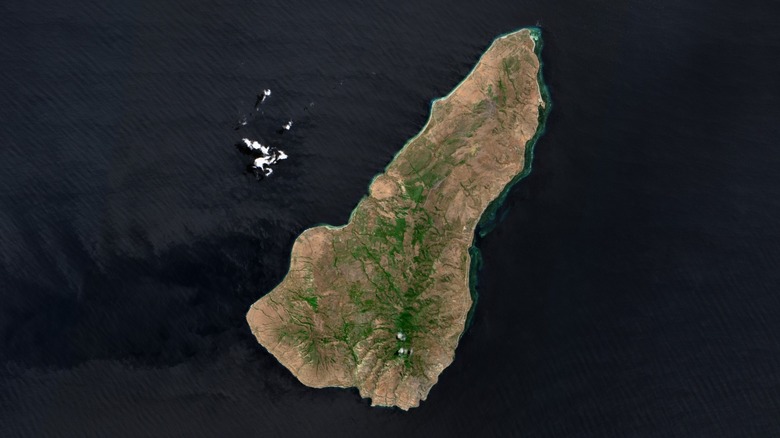A Stress-Free East Timor Island Is An 'Untouched Ecotourism Gem' With White Sugar-Sand Beaches
To step foot on Ataúro Island's soft sands is to take a trip back in time. Locals still practice a traditional way of life that has been passed down over generations, and things move slowly here — you're on island time, after all. Walk down endless stretches of sugar-white shoreline fringed with verdant palm trees, feel the tropical sunshine on your skin, and take in the scent of sea salt. This is your vacation spot in paradise.
Ataúro Island can be found in Timor-Leste, which gained independence from Indonesia in 2002. It's located among the stunning islands of Southeast Asia, just 15 miles off the Timorese mainland and 22 miles from the capital, Dili. Referred to as "the untouched ecotourism gem of Southeast Asia" by Ataúro's tourism board, this island offers everything a traveler needs for an escape into nature: lush forests, towering mountains, freshwater springs, and an abundance of wildlife. But the coral reefs encircling the island are the real star of the show. Timor-Leste is part of the Coral Triangle, a marine area spanning 2.3 million square miles across six countries, containing 76% of the world's coral species. A 2016 research project by Conservation International on Ataúro Island's reefs revealed that one site alone had a record 642 species, some of them rare or entirely new. As a result, these reefs were designated the world's most biodiverse.
And while there's a spectacular array of vibrant coral and marine life to feast your eyes on below the water, the pristine beaches above the water shouldn't be overlooked either. So, whether you're looking to dive or become a professional beach bum, Ataúro's understated beauty and wide range of activities for island fun won't fail to impress.
Activities for all types of travelers
Timor-Leste has — at various points — been colonized by Portugal, invaded by Japan, and occupied by Indonesia, and throughout, the Timorese people have shown remarkable resilience and a commitment to keeping their local traditions alive. Ataúro in particular offers many opportunities to learn about this important history and the diverse cultural traditions of its people. Head to the bustling Beloi Market on Saturday morning for delicious local eats (such as fresh Akrema pomegranates and barbecued octopus) and to find handcrafted goods. Explore the capital, Vila, by tuk-tuk or on foot and take in the stunning sea vistas, purchase handmade dolls from the Boneca women's cooperative, and view the old colonial prison site. You can also tour some of the remote villages like Anartutu, the highest settlement on the island.
For the adventurous soul, a diving or snorkeling trip is a must. There are several tour operators on the island that can make your underwater dreams a reality, including the highly reviewed Atauro Dive Resort and Compass Diving. See coral reefs exploding in color on pinnacles and along deep walls. Look out for unique fish species (some endemic to the region), including the Picasso triggerfish, Napoleon wrasse, crocodile flathead, chevron barracuda, and spotted eagle ray. If you're on the island between October and November, note that it's migration season for the pygmy blue whales, and you can book a tour to snorkel near these extraordinary creatures.
Finally, if you're looking to escape into nature, there are plenty of hiking options, from easy coastal jaunts to more challenging, multi-day treks. Hike from Bikeli to Akrema to explore Ataúro's northeastern coastline. You'll start at the hot water springs, wander through lush mangrove forests, pass a shipwreck on land, and end up on a white-sand beach.
Staying and dining on Ataúro Island
As Timor-Leste is still developing its tourist infrastructure, you won't find many five-star resorts, like this luxe eco-resort in Indonesia. But this should be an attractor rather than a deterrent, as you'll still experience unique, homey, eco-friendly spots. You'll also notice that pickings are slim on popular booking platforms like Agoda, Airbnb, and Booking.com. It's best to contact accommodations directly through their website or social media. Some guesthouses need to be booked on messaging apps like WhatsApp, as they don't have personal websites.
On Ataúro Island, your main choices for lodging will be hotels, eco-lodges, guesthouses, and homestays. For a more luxurious, all-inclusive experience, stay at Beloi Beach Hotel. You'll enjoy a spacious suite with air-conditioning, hot water, 24-hour electricity, and an ensuite bathroom. If you'd prefer to stay in Vila, then Manucoco Rek is a comfortable option. Only some of these thatched-hut rooms offer private bathrooms, but all rooms come with fans and mosquito nets. There is an on-site restaurant serving up classic Italian favorites, including handmade gnocchi and pizza (an Italian Catholic priest helped set up the restaurant). The owners and staff are friendly and warm, and they'll ensure that you have an enjoyable trip.
Finally, for a more intimate and authentic (and budget-friendly) experience, consider doing a homestay booked through tourism group ATKOMA. You'll be directly supporting a local family and can connect more deeply with your hosts and with Timorese culture. Depending on the stay, you may be treated to daily home-cooked meals, personalized island tours, and beach access.
Planning your visit to Ataúro Island
To get to Ataúro Island, you'll need to first fly into Dili. There are no non-stop flights to Timor-Leste from the U.S. or Europe, and most flights will have two or three stopovers. You'll likely connect in Sydney, Melbourne, or Brisbane before flying to Darwin, Australia, if you're coming from an American city. Apart from Darwin, there are daily direct flights to Dili from Bali, so you might consider spending some time in this nature-lover's paradise and surfer's haven, too. But before you go, make sure to read these essential travel hacks for your tropical vacation to Bali.
Once in Dili, U.S. nationals and citizens from most other countries can be issued a tourist visa upon arrival for 30 days. It costs $30 and can be renewed once (for $40). Then, you'll need to cross the Wetar Strait to reach Ataúro — either by air or water. MAF (a non-profit air ambulance) is the primary aviation option and can be booked directly through its website. The flight is just 15 minutes, and you'll get a wonderful aerial view of the stunning mountainous archipelago below. At the time of writing, flights are available in both directions once a day on Mondays, Wednesdays, and Fridays, and it's $150 per person for a round trip. The cost goes to subsidizing MAF's important humanitarian work in Timor-Leste.
Traveling by boat is much more convenient, with more times and days available. You can choose from local boats, passenger ferries, hotel-run water taxis, and private charters. Prices and length of journey will vary, but a ticket will typically run you anywhere from $4 to over $75 — and it can take from a little over an hour to three hours, depending on the boat and service you select. However, it'll be worth the journey once you arrive in this stress-free island paradise.



